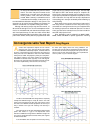
are used in some circumstances.
Remember that although the signal lev-
els are the same, the actual brightness of light from each
primary is not the same, that is determined by calibrating
the reference white color to D65.
Changing the signal levels of all primary colors
together does not change the CIE (x,y) chromaticity of a
c o l o r. Color bars with 50 percent signal amplitudes would
have the same (x,y) coordinates as color bars with 75 per-
cent signal amplitudes. The difference is that the bright-
ness of the color bars will change with amplitude, but
brightness information is not included in the CIE Chro-
maticity Diagram.
Notice that a complementary color lies on the exten-
sion of a line connecting its missing primary and the refer-
ence white point. This follows from the fact that adding
equal signal levels of a primary and its complementary
color must create the reference white, and the rule that any
color lies on a line between the two colors creating it. That
latter rule also means that the complementary color lies on
the line connecting its two primary components. Hence the
intersection of these two lines geometrically locates the
(x,y) position of the complimentary colors. (See Figure 6)
The (x,y) coordinates can also be calculated using a
mathematical analysis based on the coordinates of the
phosphors and white point. The (x,y) coordinates for each
color in the color bars based on the SMPTE C phosphors
and the D65 white point is shown in Table 1.
We can measure the (x,y) coordinates for each color in
the test pattern directly from a display
using a sophisticated electro-optical
instrument known as a color analyzer (or a spectro-
radiometer) and plot the results along with the SMPTE C
standard colors to display the errors.
At this point you might realize that the color accuracy
for a display being driven by RGB signals is pretty cut and
dry. Once the primary colors are determined and the white
point set, the color accuracy
is determined. The variable
for any display is its variation
in grayscale color tempera-
ture, which means the white
p o i n t ’s (x,y) coordinates
change with brightness level.
If the white point moves
around, we can see from the
simple geometric analysis
that the complementary col-
ors will move on the edges of
the display’s RGB triangle. Of
course, the (x,y) point for
other color signals will also
move around proportionally
inside the color triangle cre-
ating errors.
Some of you may wonder
if it isn’t possible to convert
the RGB video signals from
the SMPTE standard to
match a non-standard set of
display primaries, thereby
avoiding color errors. The
answer is yes, within the lim-
its of the display’s color
gamut, but it is more complex
than one might expect
because the RGB signals are
non-linear. Why they are non-
V I D EO
Fig. 6


















